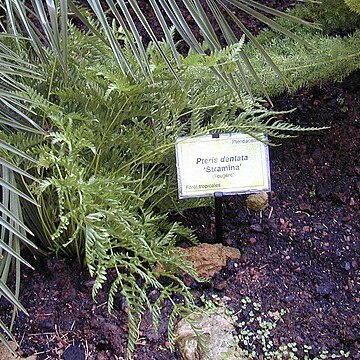Plants terrestrial. Rhizome erect to suberect, simple or sparsely and closely branched, to 70 mm long, to 12 mm in diameter, closely set with roots, stipe bases and scales, scales chartaceous, ferrugineous, sessile, oblong-acuminate, to narrowly lanceolate, cordate to cordate-imbri-cate, the margins regularly set with long, simple and branched, pluricellular, uniseriate hairs, of which the apical cell terminates in an oblong cell, the scale apex terminates in a short uniseriate row of cells, the apex terminates in an oblong cell, to 6 mm long, to 1 mm wide. Fronds caespitose, to 1 m long, suberect to arching, to 7 per plant; stipe firm, proximally castaneus, stramineous to yellowish distally, adaxially sulcate, to 410 mm long, to 4.5 mm in diameter, variously set with hairs and scales, the hairs pluricellular, uniseriate, simple or branched, the apex terminates in an oblong thin-walled cell, proximally sparsely set with scales similar to those on the rhizome, glabrous distally; lamina anadromous, catadromous towards apex, pentagonal in smaller fronds, ovate when mature, 2-pinnate, to 620 mm long, to 480 mm wide, with up to 9 pinnate or lobed pinna pairs; rachis stramineous to yellow, adaxially sulcate, glabrous; pinnae petiolate, petiole to 17 mm long, opposite to alternate, basal pair largest, overlapping, basal (often also second proximal) pinna pair with up to 5 pinnules basiscopically and up to 3 acroscopically, inequilaterally ovate to triangular, to 330 mm long, to 200 mm wide, distal pinnae spaced or slightly overlapping, narrowly ovate, pectinately lobed, to 210 mm long, to 72 mm wide; pinna-rachis and costa adaxially sulcate, sulci confluent, adaxially with prickles where costae branch from the higher order axes; pinnules petiolate, petiole to 7 mm long, alternate, proximal basiscopic longest, narrowly ovate, pectinately lobed, to 180 mm long, to 50 mm wide; lobes herbaceous, linear-acute, often somewhat falcate, widening towards base, basiscopically decurrent, serrate in sterile fronds, entire in fertile parts, to 55 mm long, to 6 mm wide, adaxially glabrous or with a few scattered 2-celled hairs along veins, abaxially sparsely set with simple, 4-6-celled hairs along or near veins, to 320 µm long; costa adaxially shallowly sulcate, without, or with short inconspicuous prickles. Venation anadromous and/or catadromous, evident, forked once, free in sterile parts, ending near margin, veins anastomose and form a near-marginal vascular commissure in fertile parts. Sori linear, continuous along a near-marginal vascular commissure, along proximal part of lobes; receptacle paraphysate, paraphyses simple, pluricellular, apical cell enlarged, to 370 µm long; sporangium long-stalked, simple or with a simple pluricellular hair near base, 3-seriate below capsule, capsule elliptic to obovate in lateral view, annulus with 17(-18) indurated annulus cells, epistomium 3-or 4-celled, hypostomium 4-celled; indusium a recurved margin bearing stomata in lower half, thinly herbaceous, linear, entire to repand, to 0.5 mm wide. Spores 64 per sporangium, brown, tetrahedral, trilete, with an equatorial flange, proximal and distal face verruculose, exospore (30-)31(-32) µm in equatorial diameter.
More
Rhizome erect to suberect, simple or sparsely branched, up to 70 mm long, up to 12 mm in diam., with stipe bases and scales; scales ferruginous, chartaceous, oblong-acuminate, to narrowly lanceolate, up to 6 x 1 mm, margins with long, simple and branched hairs. Fronds caespitose, up to 1 m long, suberect to arching, up to 7 per plant. Stipe firm, up to 410 mm long, up to 4.5 mm in diam., proximally castaneous, stramineous to yellowish distally, adaxially sulcate, variously set with hairs and scales. Lamina pentagonal in smaller fronds, ovate when mature, up to 620 x 480 mm, 2-pinnate, with up to 9-pinnate or lobed pinna pairs. Rachis stramineous to yellow, adaxially sulcate, glabrous. Pinnae opposite to alternate, basal pair largest, overlapping, up to 330 x 200 mm, distal pinnae spaced or slightly overlapping, narrowly ovate, up to 210 x 72 mm, pectinately lobed; petioles up to 17 mm long. Pinnules alternate, proximal basiscopic longest, narrowly ovate, up to 180 x 50 mm, pectinately lobed; lobes herbaceous, linear-acute, up to 55 x 6 mm, often somewhat falcate, widening towards base, basiscopically decurrent, serrate in sterile fronds, entire in fertile parts; costa adaxially shallowly sulcate, with or without short inconspicuous prickles; venation evident, forked once, free in sterile parts, anastomose and forming a near-marginal vascular commissure in fertile parts; petioles up to 7 mm long. Sori linear, continuous along a near-marginal vascular commissure, along proximal part of lobes; receptacle paraphysate. Indusium a recurved margin bearing stomata proximally, thinly herbaceous, linear, up to 0.5 mm wide, entire to repand.
Rhizome erect to procumbent, up to 10 mm in diameter, set with linear-lanceolate, atrocastaneous, nitid rhizome-scales up to 5 mm long with sparse, pale, marginal cilia. Fronds tufted, herbaceous, arching; stipe stramineous, becoming atrocastaneous basally, glabrous, up to 0.5 m long; lamina ovate, up to 1 x 0.4 m, usually 3-pinnatifid, basal pinnae markedly developed basiscopically; middle pinnae narrowly oblong, attenuate, deeply pinnatifid into decurrent lobes up to 32 x 5 mm, serrate towards the apices, glabrous on both surfaces, costa spinous ventrally; veins free; rhachis sulcate, stramineous to somewhat castaneous, glabrous, smooth. Sori in a marginal line extending for most of the length of the ultimate lobes; indusium erose or subentire, membranous.
Rhizomatous perennial. Fronds arching, to 1.5 m long, stipe glabrous, lamina ovate, 3-pinnatifid, proximal pinnae basiscopically developed, deeply pinnatifid, lobe apices serrate, veins free. Null Sori in a marginal line, indusium erose.
Rhizome erect to procumbent, set with atrocastaneous rhizome scales. Lamina ovate, up to 1 x 0.4 m, usually 3-pinnatifid. Basal pinnae shorter than lamina. Sterile apices of fertile and sterile lobes crenate-dentate.
Rhizome erect or creeping with blackish chestnut shining linear-lanceolate scales 5 mm long.


